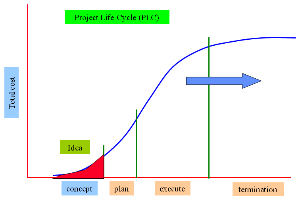Risk management - Project Life Cycle - concept
Project Life Cycle
CONCEPT
Idea
At the start of a project there will be an idea or initial concept. This will exist to satisfy an opportunity or need.
Details of the ‘product’ will be very sketchy and may require some initial activity to put some ‘flesh on the bones’ of the concept to show that there is some merit in the idea.
The objectives for the ‘product’ are likely to be loose in the sense that boundaries may exist in terms of cost, performance, delivery dates etc.
At this stage the activity is trying to refine the ‘idea or concept’ and does not constitute an acceptance of the project at this stage.
Each stage leads into the next.
On collecting and reviewing the data from an initial ‘feasibility’ study there will be a decision point to proceed.
This is usually seen as a GO / NO GO decision point.
However, these decision points are best seen as GO / NO GO / MAYBE.
The MAYBE covers the option of needing to review certain aspects of the ‘idea’ and the collection of more data to justify a GO or NO GO.
Clearly, it is a key risk to proceed to the next stage for any of these phases if they are in anyway incomplete.
The data to collect could be technical to show that the product could do what it is designed to do and that it is feasible to make it.
Alternatively, if the product is required for sale or to satisfy a particular market then the necessary supporting data will be required.
At this stage we should identify all STAKEHOLDERS and their expectations with perceived performance criteria.
This does not mean setting them but identifying which ones are needed.



